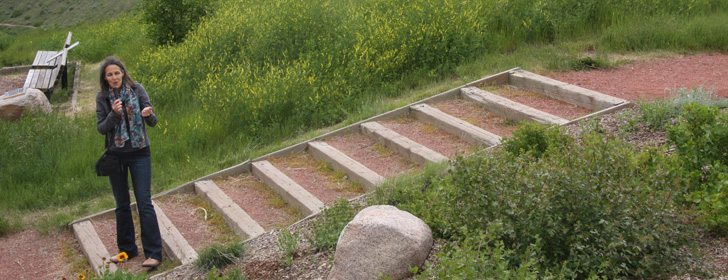Planning and design
Dry conditions are more common on the Prairies than excess moisture, the last two years notwithstanding. Gardeners are well aware of this and many have embraced the concepts of xeriscaping that include practical ways to use water in yards and gardens.
June Flanagan knows all about gardening in dry areas. The Lethbridge author was a student in an Arizona environmental horticulture program when the concepts of xeriscaping were first spawned.
Since then, she has obtained a masters degree in plant science and a degree in environmental horticulture, and has written several gardening books. Among them are Native Plants for Prairie Gardens and The Prairie Gardener’s Sourcebook.
Read Also

Phosphate prices to remain high
Phosphate prices are expected to remain elevated, according to Mosaic’s president.
Flanagan is an often-sought speaker in southern Alberta gardening circles. She told a group of Lethbridge gardeners this summer about the seven concepts of xeriscapes that have stood the test since their conception in the late 1970s.
1. Irrigate
“Irrigate before 10 o’clock in the morning,” says Flanagan, and do it deeply but infrequently.
“By doing that you put down quite a bit of water at one time and then you wait until the soil starts to dry out before you irrigate again. What happens is you’ll encourage deep rooting in your plants.”
She advises watering at soil level with soaker hoses or a drip system. A shallow basin around trees, with the rim extending to the edge of the leaf canopy, can be filled with water and left to dry out before watering again.
Lawns are major water users and Flanagan advises limited space devoted to lawns if xeriscape is the goal.
“It’s a good idea to reduce the size of your lawn and your bedding out plants because these areas need about an inch … of water every week.”
Gardeners who use sprinklers should calculate how much water is applied in a given period.
One way to do this is to set out a shallow container and time sprinkler activity until one inch of water is applied. Then users will know how long to let a sprinkler run with each water application.
“Remember that all of the plants you install will need regular irrigation to get the roots established,” Flanagan added.
Even native plants need some water, and trees and shrubs will need regular watering for at least the first few years after planting, until they are well established.
2. Mulch
Flanagan said this is an easy concept to apply without making any other changes to the garden.
“Every part of your garden should be mulched except for the lawn, even the containers,” she says.
She favours organic mulches including wood chips, which decompose slowly and hold moisture in the soil. Around trees and shrubs, she recommends chips about eight centimetres deep, tapered to be shallower near the trunk.
Wood chips are not a good choice for the vegetable garden because they are chunky and can tie up nitrogen needed by plants, Flanagan says. She recommends lighter mulches such as compost or grass clippings for the vegetable garden.
She likes organic mulches better than rock mulches because they insulate the soil and encourage plant root growth, prevent frost heaving and eventually add organic matter to the soil.
“A rock chip mulch won’t. They will help hold water. However, they don’t add organic matter to the soil. They increase the heat load on your plants, which sometimes means you have to water your plants more often. They also can increase the heat load on your home.”
Rocks are also traps for bits of soil and weed seeds, leading to higher maintenance. They are also difficult to move if changes to the garden are planned.
3. Maintain the landscape
“The biggest thing here is to weed, because weeds will take moisture and compete with your plants for moisture.”
Regular weeding and fertilizing will keep plants healthy so they need less water. It also reduces the need for chemical controls.
4. Design to conserve water
Flanagan recommends that water conservation be part of garden design. Choose plants that suit the conditions and place plants with similar water and sunlight needs together.
She suggests putting plants with higher water needs, including lawn, near the house for ease of watering. This can help cool the house in summer.
Trees and shrubs can also serve this purpose.
5. Reduce or eliminate lawn
Flanagan says most lawn grasses are cool season plants that go dormant when it gets too hot. Adding water is the only way to keep them growing and green.
“I don’t advise you not to water, because our summers are so short, we want to enjoy whatever bit of plant growth that we can get. But I will advise you to reduce the size of your lawn,” says Flanagan.
Sod is hard to remove so she suggests doing it in stages. Remove some lawn each year and replace it with perennials, shrubs or trees.
“Eliminating lawn altogether is the biggest thing you can do to conserve water.”
6. Choose water-wise plants
Flanagan recommends the use of native plants that are adapted to the climate and thus drought tolerant. In 2008, she helped Lethbridge volunteers build a native plant garden near the city’s museum. The variety ensures that something is blooming throughout the growing season.
“You don’t need to give up beauty,” says Flanagan, noting the attributes of shrub roses, mock orange, lilacs and evergreens.
“Lots of things that we consider classic garden plants also use water wisely.”
7. Replenish the soil with organic matter
Mulch and compost are the keys to this goal, Flanagan says. She recommends compost applications to vegetable gardens just before planting and again around July 1.
What is a xeriscape?
It is a yard or garden that follows principles of being practical and environmentally friendly. The term xeriscape comes from the Greek word ‘xeros’ meaning dry and ‘scape’ as in landscape. Xeriscaping is not the same as zero-scaping and does not focus on rocks, stone and gravel but on the following seven principles.
- Sketch your yard, including decks, trees and sheds
- Zone each area by activity or purpose
- Colour code areas by amount of sunlight, precipitation and water needs.
Improve the soil
Add two or more inches of organic matter like compost or aged manure and mix to a six-inch depth.
Create practical lawn areas
- Limit lawn area to what is need and where it provides a function.
- Choose grass seed mixes that have low water requirements.
- Where lawn is hard to grow or maintain, consider replacing grass with drought tolerant ground covers, perennials or shrubs. Include a path, a bench or a sculpture.
Water efficiently
- Group plants by water needs and zone lawn areas separately because they use the most water. Lawns require one inch per week (2.5 cm).
- Use irrigation systems that place water directly on ground such as drip systems or soaker hoses.
- Avoid sprinklers that shoot water high into the air, produce a fine mist or oscillate.
- Watering in the early morning is best because it is cooler and allows leaves to dry during the day.
- Use rain barrels and water less when it rains.
Select appropriate plants and group by water needs
- Place plants with high water needs in low-lying areas that will naturally receive drainage and are convenient for irrigation.
- Select plants based on structure, colour, texture or fragrance. Plants that are native to the Prairies are accustomed to the dry climate and naturally require less water.
Use mulch to reduce evaporation
- Mulches reduce evaporation, cool the root zone, reduce weed growth, slow erosion and look great. Wood chips and shredded bark feed the soil with organic matter.
Maintain your xeriscape
- Prune dead or diseased branches anytime. Most other pruning can be done in winter or early spring.
- Remove spent flowers throughout the summer before they mature into seed heads.
- Aerate lawns in spring and mow regularly to height of three inches. Leave clippings to provide nutrients.
- Fertilize according to plant needs. More is not better.
Source: Oldman Watershed Council
















